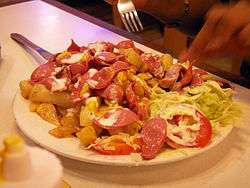Salchipapa
A salchipapa or salchipapas is a fast food dish commonly consumed as street food. The dish's name is a portmanteau of the Spanish words "salchicha" (sausage) and "papa" (potato). Salchipapas typically consist of thinly sliced pan-fried beef sausages and French fries, mixed together with a savory coleslaw on the side. The dish is served with different sauces, such as ketchup and mustard, crema de aceituna (olive sauce), along with aji or chili peppers. Sometimes a fried egg or cheese is added on top; it can also come with tomato and lettuce, and is occasionally garnished with oregano.
 | |
| Type | Fast food |
|---|---|
| Main ingredients | French fries, beef sausages, sauce (typically ketchup and mustard), chili peppers |
History

The salchipapa was invented as a street food in Lima, Peru.[upper-alpha 1] Over the years, it expanded to other places in Peru.[2] In Latin America, the dish's popularity has expanded beyond Peruvian cuisine, and is now also typical of Ecuadorian and Bolivian cuisine. The dish is also sold on Argentinian streets and markets.[3][4]
The range of the dish keeps expanding due to the Bolivian immigration in Argentina and Peruvian restaurants in the United States and Chile.[5] There's a variant known as "choripapas" (made with chorizo instead of sausage). They can also be found in Mexico.[6]
Gallery
 Some restaurants modify the salchipapa recipe to refine the traditional street food.
Some restaurants modify the salchipapa recipe to refine the traditional street food. Salchipapa consumption remains strong in the urban sectors of Lima.
Salchipapa consumption remains strong in the urban sectors of Lima. The salchipapas' high amount of calories are a cause concern for advocates of public health.
The salchipapas' high amount of calories are a cause concern for advocates of public health.
Footnotes
- Chef Dan Perlman defines the dish as a "street food from Lima (Perú)".[1]
References
- Perlman 2007.
- Jenkins, Dilwyn (2003). Rough Guide to Peru. Rough Guides. ISBN 978-1-84353-074-9.
- Adés, Harry; Melissa Graham (2003). The Rough Guide to Ecuador. Rough Guides. ISBN 978-1-84353-109-8.
- Donadío, Pablo (2008). Un paso en el camino. Página12.
- Canelo, Brenda (2011). Procesos transnacionales y Estado subnacional en una ciudad latinoamericana. Comisión Económica para América Latina y el Caribe (CEPAL).
- Lozano, Fernando (2011). Salchipapas y churros: ¿cómo se comen estos platos en México?. El Comercio.
Bibliography
- Perlman, Dan (2007). SaltShaker: Spanish - English - Spanish Food & Wine Dictionary. Raleigh, North Carolina, USA: Lulu Press. ISBN 978-1-4303-2659-5.CS1 maint: ref=harv (link)
External links
| Wikimedia Commons has media related to Salchipapa. |
- South American Food – Website about Salchipapas.